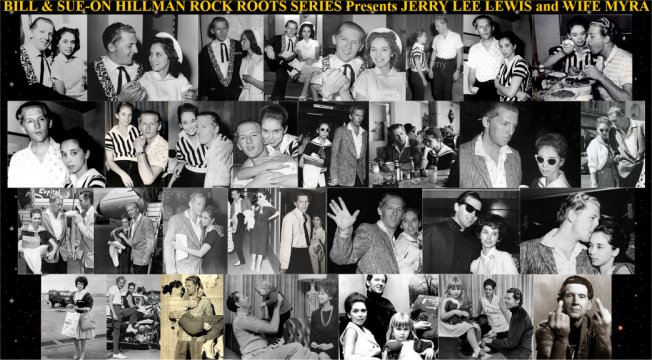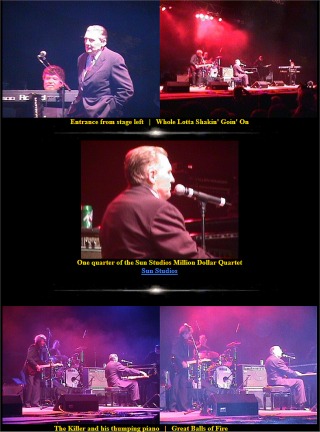Jerry Lee Lewis,
flamboyant and controversial
rock and roll pioneer,
dead at 87
Ref: CBC
News
Performer known as The Killer
was inducted into inaugural Rock and Roll Hall of Fame class
Jerry Lee Lewis, the hard-living, hard-playing
pianist and singer whose offstage exploits often grabbed as much attention
as his electrifying performances and genre-spanning recording career, has
died. He was 87. The last survivor of a generation of groundbreaking performers
that included Elvis Presley, Chuck Berry and Little Richard, Lewis died
at home in Memphis, Tenn., representative Zach Farnum said in a release.
Lewis had suffered a minor stroke
in 2019 but frequently performed live shows until then. More recently,
he was unable to attend his Country Music Hall of Fame induction due to
illness.
Lewis's legacy was largely established
on the mostly raucous sides cut over a three-year period at Sun Records
in Memphis: Whole Lotta Shakin' Goin' On, Great Balls of Fire, Breathless
and High School Confidential. A serendipitous session there of future
music legends on Dec. 4, 1956 would also loom large — with the songs recorded
by the so-called Million Dollar Quartet of Lewis, Elvis Presley, Johnny
Cash and Carl Perkins sold and repackaged in the ensuing decades.
Lewis's appeal to baby boomer kids
entranced by the new genre called rock 'n' roll was boosted by manic performances
on The Steve Allen Show and in the motion picture High School Confidential.
Lewis's hair flipped and flopped as he pounded the keys, yipped and yodelled,
kicked the piano bench aside and played standing up or even with his feet.
"The Killer" — Lewis's nickname
stemming from a colloquial childhood greeting — was inducted into the inaugural
1986 class of the Rock and Roll Hall of Fame and received a Grammy lifetime
achievement award. Not a prolific songwriter, Lewis received credit for
putting his definitive stamp on songs that originated across genres --
R&B, country, gospel, he loved it all.
Scandalous Marriage
Lewis's life played out like a Southern
Gothic novel manuscript rejected for being too over the top. There were
seven marriages, a near-fatal shooting, perennial IRS troubles due to tax
delinquency and habitual car crashes, including an infamous 1976 arrest
in which a pistol-packing Lewis crashed his Lincoln into the gates of old
friend Presley's Graceland mansion. "I am just what I am — Jerry Lee
'F--k Up' Lewis," he told the BBC in a 1990 documentary. "If you
don't like that, you can kiss my ass."
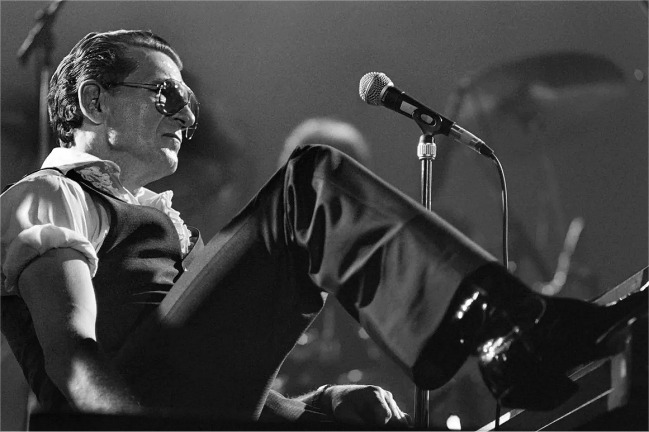
Lewis plays the piano with his feet in Bourges,
France, on April 23, 1987.
While Lewis enjoyed a recording
career that spanned more than six decades, radio airplay largely stopped
when it was learned in 1958 that he had married the 13-year-old daughter
of his bandmate and cousin, J.W. Brown, on Dec. 12, 1957. Myra Gale Brown's
account of their tumultuous 13-year marriage was told in 1982's Great
Balls of Fire: The Uncensored Story of Jerry Lee Lewis, the inspiration
for a major motion picture seven years later starring Dennis Quaid as Lewis
and Winona Ryder as Brown.
Mysterious Death
The couple's three-year-old son, Steve
Allen Lewis, drowned in 1963, while a decade later Jerry Lee Lewis, Jr.,
the oldest of six Lewis children, was killed in a vehicle accident at the
age of 19.
Journalist Richard Ben Cramer, in
one of the most famous Rolling Stone longform pieces, questioned in 1984
if Lewis had embodied his nickname to deadly consequence after his fifth
wife, Shawn Stephens, died the previous year at his Nesbit, Miss., ranch
at the age of 26 years, and just 77 days into their marriage. When first
responders arrived, Cramer reported, Lewis greeted them with slurred speech,
a bathrobe stained with dried blood and scratches on his hand. Stephens's
death was ruled a methadone overdose, and a grand jury refused to indict
Lewis, but the investigation was deemed substandard by both Cramer and
Geraldo Rivera of TV news magazine program 20/20.
"I loved her with all my heart and
soul. There's no way that Jerry Lee Lewis could ever, and would ever, even
think of taking another person's life," Lewis said on 20/20, explaining
that the blood and scratches were from punching a wall in anguish over
her death.
Hardscrabble Rural Upbringing
Jerry Lee Lewis was born at the height
of the Great Depression in Ferriday, La., on Sept. 29, 1935, one of four
children. When not travelling, he spent nearly his entire life in the heart
of the Mississippi Delta. Lewis's father picked cotton and did a short
stint in jail for selling liquor illegally. The family dwelling had no
electricity or indoor plumbing, and when Lewis was a small child, his older
brother was killed by a drunk driver.
Respite from the hard life came
largely from extended family gatherings where music was performed.
"There's a lot of piano players in my family and a lot of singers. You're
either a preacher or a rock and roll singer," Lewis told CBC's Good
Rockin' Tonite in 1989. "I chose rock and roll."
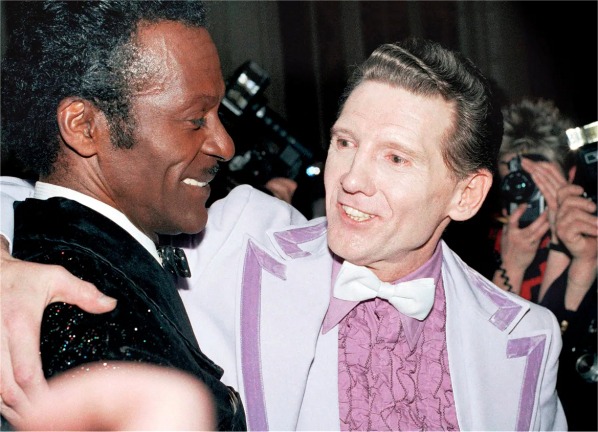
Chuck Berry, left, and Lewis embrace at a
reception
at the Waldorf-Astoria in New York on Jan.
23, 1986,
when they were both inducted into the Rock
& Roll Hall of Fame.
Despite the challenging circumstances,
four members of his extended family achieved some degree of fame. Linda
Gail Lewis, his sister, and cousin Mickey Gilley were also recording artists,
and another cousin, Jimmy Swaggart, became one of the most famous American
televangelists. Pentecostal church services Lewis attended as a child made
a lifelong imprint. Throughout his life and all the hellraising that would
ensue, he was preoccupied with whether "salvation" would occur at his mortal
life's end.
At the age of eight, he displayed
an aptitude for music, inspiring his dad, Elmo, and mother, Mamie, to spend
more than they had to buy him a standup Starck piano. He was largely self-taught,
but a wide range of artists fuelled his passion, with Hank Williams and
B.B. King his favourites.
'That Boy Can Go'
Lewis played community events beginning
in his teens and snuck into clubs, with neither academia nor a stint in
Bible school holding lasting interest. His wide-legged style at the piano
bench was reportedly due to a hip injury playing football. He heard about
the exploits of Presley at Sun Records and made a pilgrimage in the waning
months of 1956. By that time he had been through a series of menial jobs
and nighttime gigs, as well as receiving a rejection from RCA Records,
whose staff were reportedly flummoxed that he didn't play the guitar.
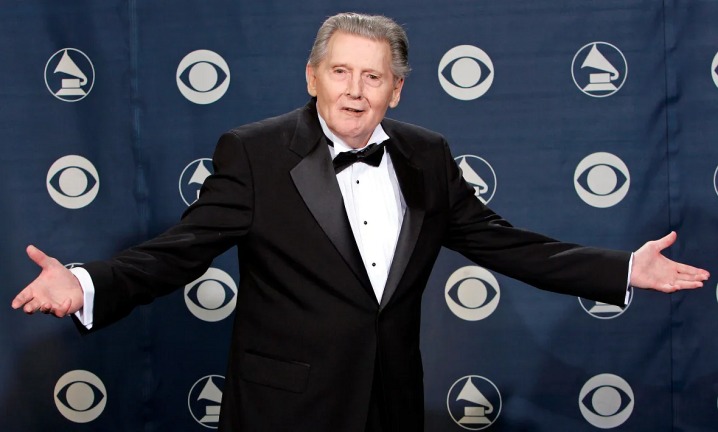
Lifetime achievement award winner Lewis poses
for photographers
at the 47th Annual Grammy Awards at the Staples
Center in Los Angeles on Feb. 13, 2005.
"Nothing could stop me. I was
going to be heard and get recorded," he told Vintage Rock magazine.
"I knew, if I got to Sun, it would happen." A reporter was on hand
for the studio session of future legends Cash, Perkins, Presley and Lewis.
"That boy can go," Presley told the scribe. "I think he has a
great future ahead of him. He has a different style, and the way he plays
piano just gets inside me." In less than two years, Great Balls
of Fire, Whole Lotta Shakin' Goin' On and Breathless were all
top-10 hits on Billboard's main chart.
Aged 22 and on his third marriage,
Lewis's union with a 13-year-old was, regrettably, not without precedent
in rural communities of the Deep South at the time. His own sisters were
married at 14 and 12, while he was 16 when he married for the first time.
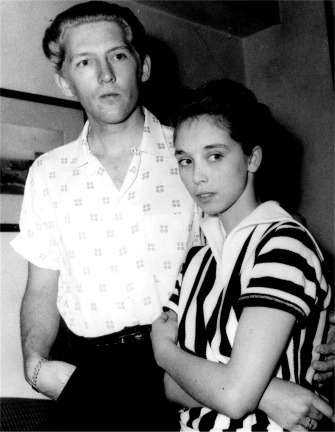
Lewis and his wife, Myra, then 15, are shown
in London on May 23, 1958.
The marriage caused controversy, and she later
alleged it had been marked by abuse.
At a 1959 court appearance regarding
tardy child support payments to his second wife, Lewis explained to a judge
that gigs had dried up due to being branded a "cradle snatcher." He played
the club and tavern circuit for much of the 1960s, including Café
Pagoda in Montreal and Toronto's Le Coq d'or Tavern, appearing on a bill
with younger musicians like John Lennon and Eric Clapton at the Toronto
Rock and Roll Revival in 1969.
During the 1970s, he found the charts
again as a country performer, with songs such as What's Made Milwaukee
Famous (Has Made A Loser Out of Me) and To Make Love Sweeter for
You.
Lewis being Lewis, trouble was never
far off. With drinks flowing in 1976, he nearly killed his bass player,
Butch Owens, with a .357 — he said he was aiming the gun at a Coke bottle.
Lewis was forced to pay damages to Owens and sentenced to probation. "I
just know it took him a couple days to talk right," Lewis told biographer
Rick Bragg decades later.
After Presley's 1977 death, it was
learned at a subsequent trial that both he and Lewis were avid customers
of pill-pushing Dr. George Nichopoulos. Dr. Nick, as he became known, testified
that amphetamines were Lewis's particular weakness and that Lewis once
discharged himself from a hospital by climbing out a window. Around the
same time — and not for the last time — Lewis was forced to hawk a number
of luxury items to satisfy tax debts owed to Uncle Sam.
In 1981, the wear-and-tear of alcohol
and drug use led to stomach surgery and a subsequent bout of pneumonia,
leaving him in serious condition for a time.
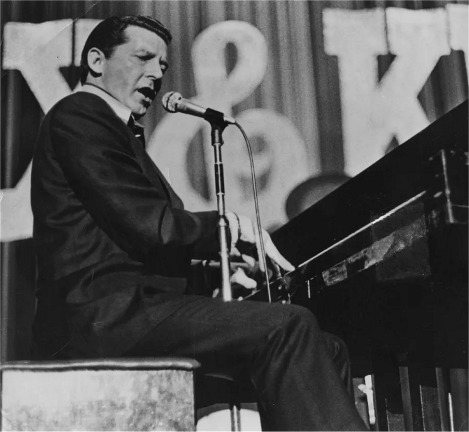
Jerry Lee Lewis, the last survivor of a generation
of groundbreaking performers
that included Elvis Presley, Chuck Berry and
Little Richard,
has died at home in Memphis, Tenn. Here, the
singer is shown performing on July 29, 1972.
1 of 12
It was at a show the following year
at the Hyatt Regency hotel in Dearborn, Mich., where he met Stephens, a
waitress. Richard Ben Cramer's 1984 Rolling Stone article, The Strange
and Mysterious Death of Mrs. Jerry Lee Lewis, was lurid. The writer pointed
out that Lewis's fourth wife, Jaren, drowned in 1982, though the article
didn't mention that the performer was nowhere near the scene of that tragedy.
Both Cramer and Geraldo Rivera alleged there had been abuse in the short
marriage to Stephens.
"She wasn't beaten at all. There
wasn't a touch of circumstantial evidence that I done it," Lewis told
Bragg in 2014's Jerry Lee Lewis: His Own Story.
'Jerry Lee Won't Be Tamed'
Lewis's reputation took a hit, and
a series of erratic performances didn't help. He was a no-show at an oldies
revue in Toronto's brand new SkyDome in 1989, and four years later, he
kicked a cameraman in Spain. In her book, Myra Gale Brown said Lewis would
subject her "to every type of physical and mental abuse imaginable"
during their marriage, and neither were fans of 1989's Great Balls of
Fire. "I played him really as a nine-year-old boy who fell in love
with music, which he still is," Quaid told Vogue in a promotional interview
for the film.
In the last three decades of his
life, Lewis still enjoyed the rush of the stage, no matter if it was a
club that had seen better days or a casino amphitheatre. After a decade
break from recording, 2006's Last Man Standing ushered in three
well-received albums in the 21st century chock-full of guest spots from
the likes of B.B. King, Mick Jagger, Neil Young, Sheryl Crow and Willie
Nelson.
As Hutch Hutchinson, a bandmate
for more than four decades at the time, told the New York Times in 2006:
"Jerry Lee won't be tamed. He doesn't answer to anybody, never has."



![]()
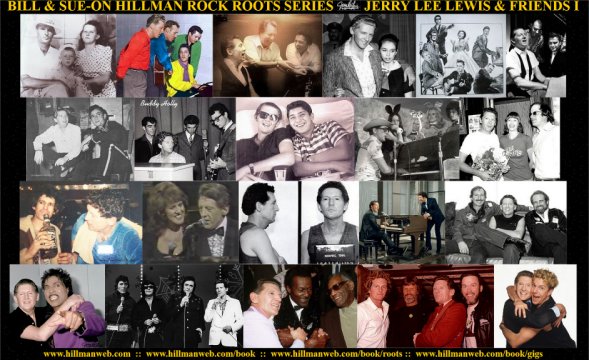
![]()
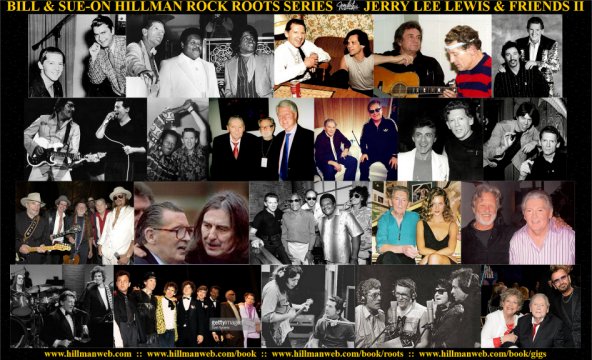
![]()
